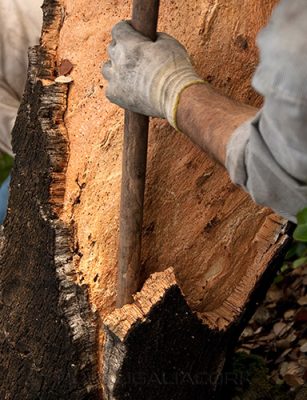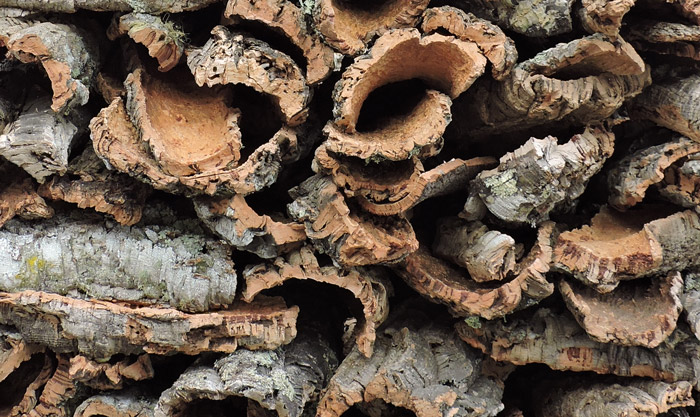ABOUT CORK
The cork tree is typical of the western Mediterranean region. It is known as Quercus suber L., and belongs to a sub-group of European and Asian oak species (Cerris). One of its most distinctive properties is the outer homogeneous layer that grows around its trunk, called cork. The continual phellogen regeneration causes the homogeneity of this layer during its lifespan. Contrary to other species, with limited phellogen production capacity, the cork oak tree keeps regenerating over and over again.
As stated before, the words “waste” and “cork tree” don’t go together. Cork trees might be one of the most versatile trees ever to grace the world. The acorn, its fruit, serves as food for other animals, to further seed new trees, and to produce culinary oil. Moreover the leaves can be used as natural fertilizers and fodder for the animals.
The tree’s pruning results in vegetal coal and wood, useful for many immediate communities and post-processed products. The cork tree oils also find an interesting application through its chemical properties, such as directly natural beauty products.

Discover The Art of Cork Harvesting
The process of cork extraction commonly referred to as “descortiçamento” is a very skilled task. It’s a carefully laid out procedure, with several steps in which the cork is extracted from the cork tree with a special machete. It has been passed on by generations of men and women specialized in doing this for a living, requiring manual precision and experience.
Cork’s life cycle begins with this extraction process. During the Summer months of May to August, the harvest takes place. These are months where the cork’s growth is at its highest. Although it seems somewhat straightforward, it needs special attention to detail given the tree’s development’s particular requirements.
It takes 25 years until the first cork can be extracted from a Cork tree. Each trunk needs to reach 27,5 inches in diameter and 51 inches of height from the ground level. From this stage onward, the tree can produce cork every nine years for about a century and a half.

Cork Harvesting Stages
Discover the sustainable journey of cork harvesting and its benefits for the environment.

Stage 1: VIRGIN CORK
The first extraction is called desbóia. The cork retrieved from this first strip is irregular, tough, and very difficult to work with. It is also commonly known as virgin cork. It will be used for purposes such as decorative panels, flower pot vases, animal hides and other applications.
After removal, the tree is tagged with the extraction year, so the workers can know when to get back to it to extract more cork.

Stage 2: SECUNDEIRA
The second extraction of the cork tree after the first nine years is called secundeira. Although much more malleable and regular than the initially extracted cork, it is still not the highest quality cork.

Stage 3: AMADIA
The third harvest marks the beginning of the material’s maturity and highest level of quality. From this stage forward, every nine years, the harvested cork is the best quality possible. This is the cork used in the manufacture of the best natural cork stoppers used to age the best wines worldwide. This cork is designated by amadia or reproduction (cork).


